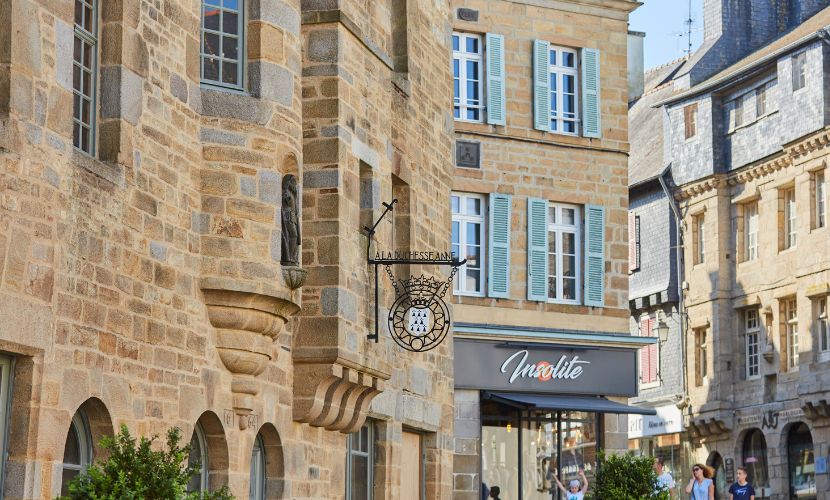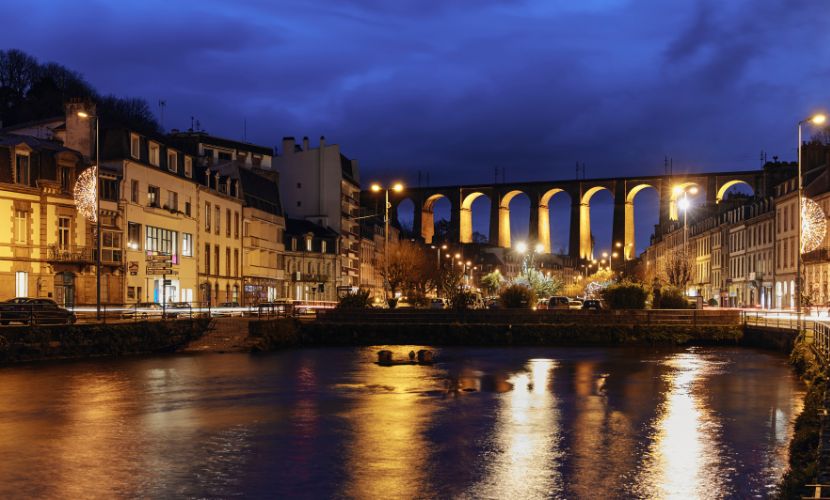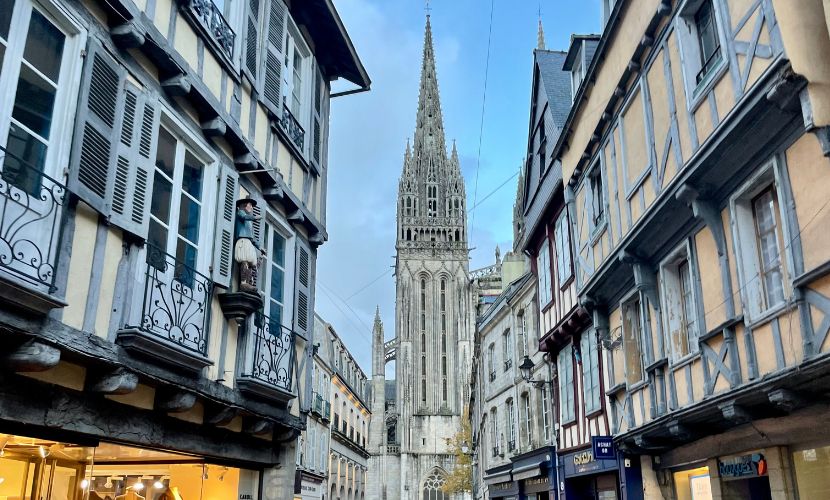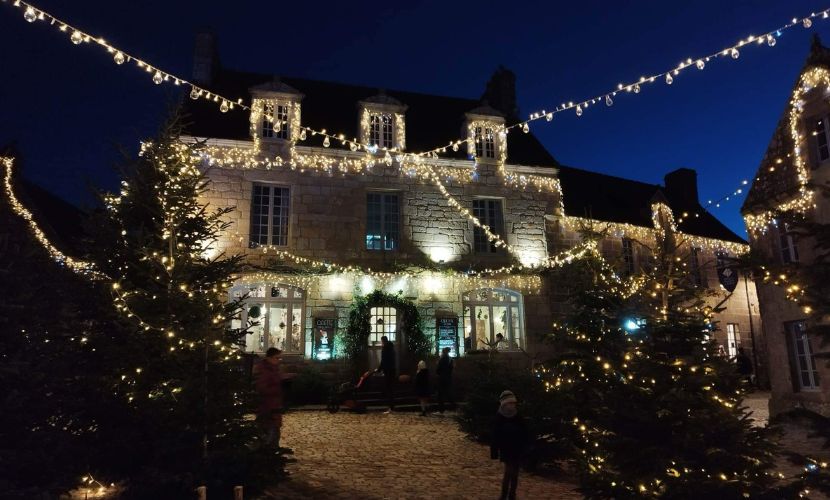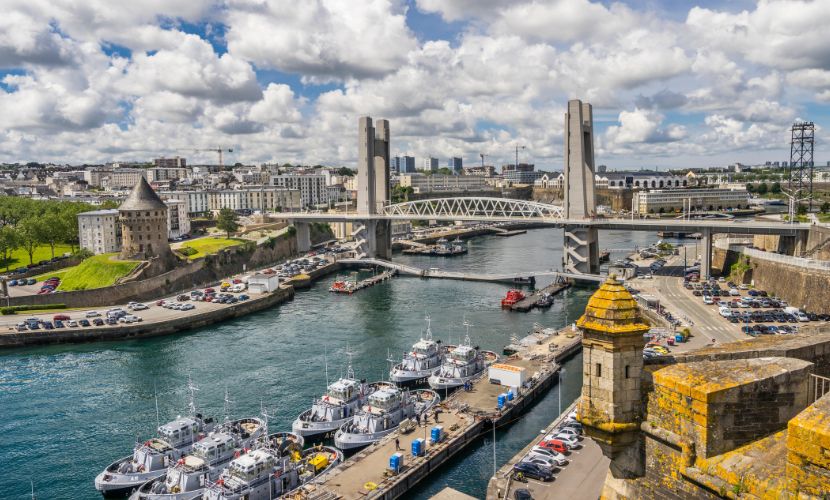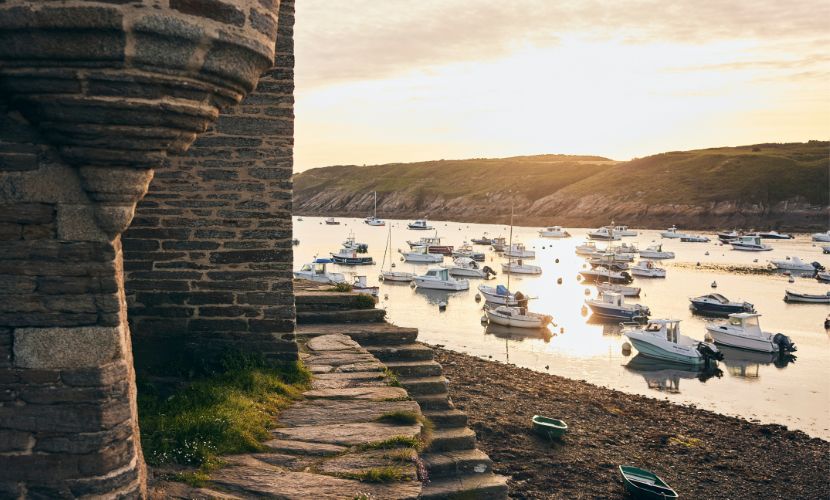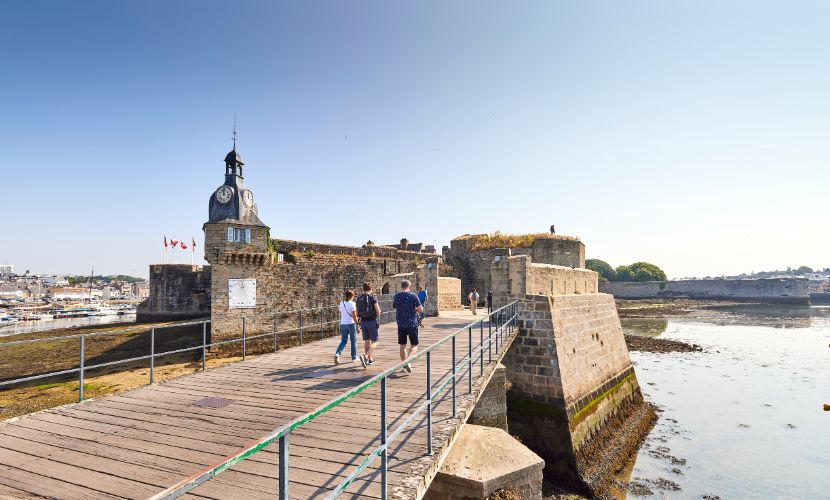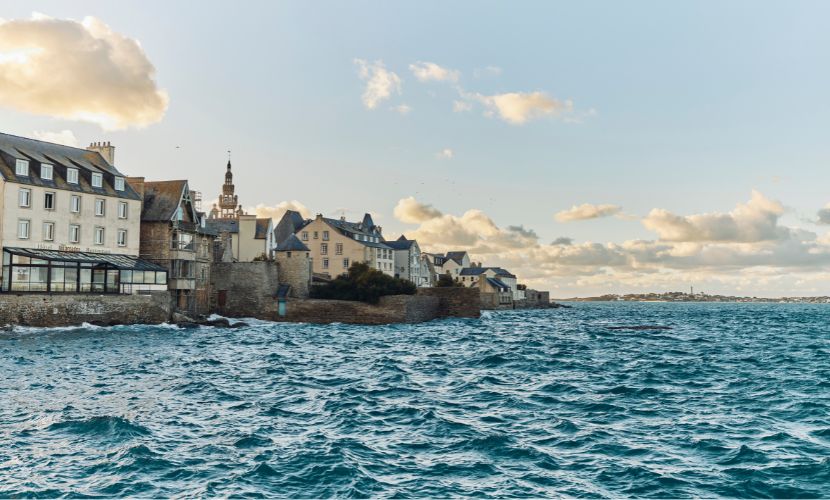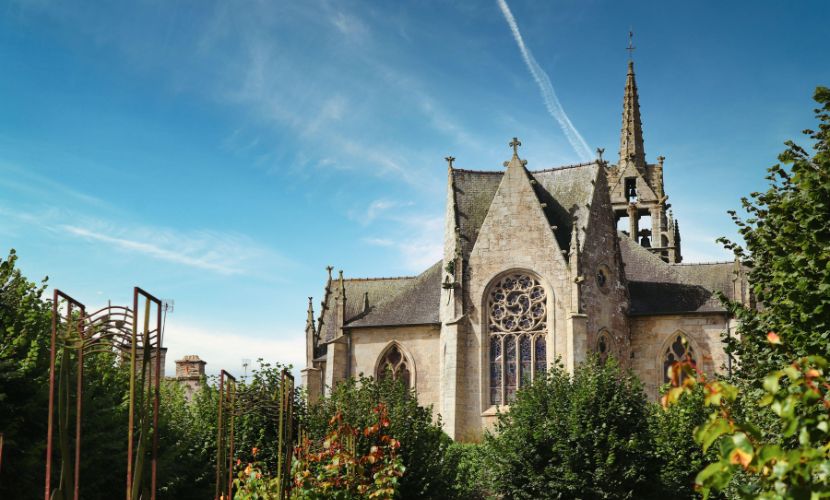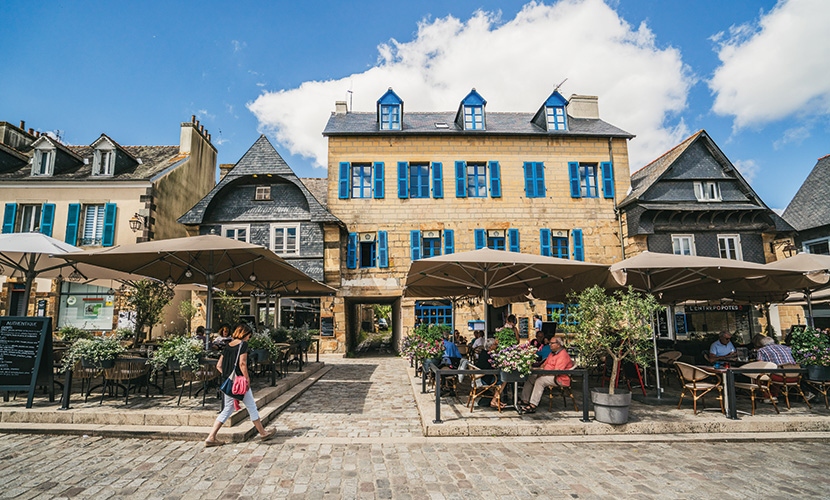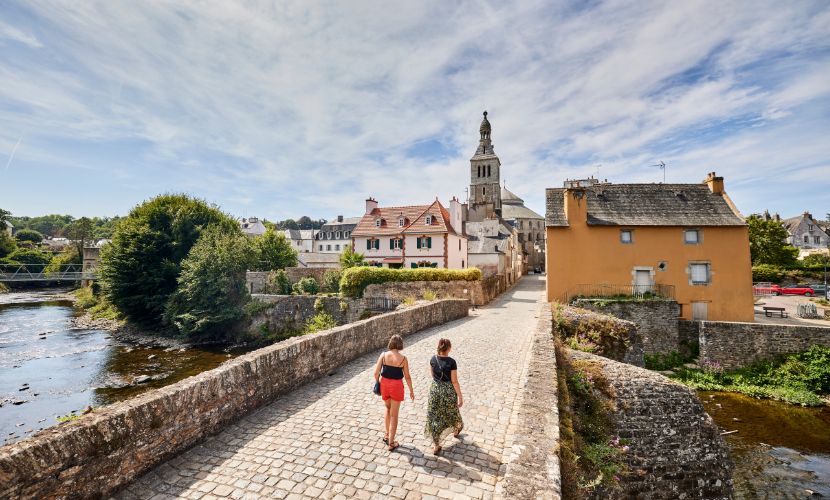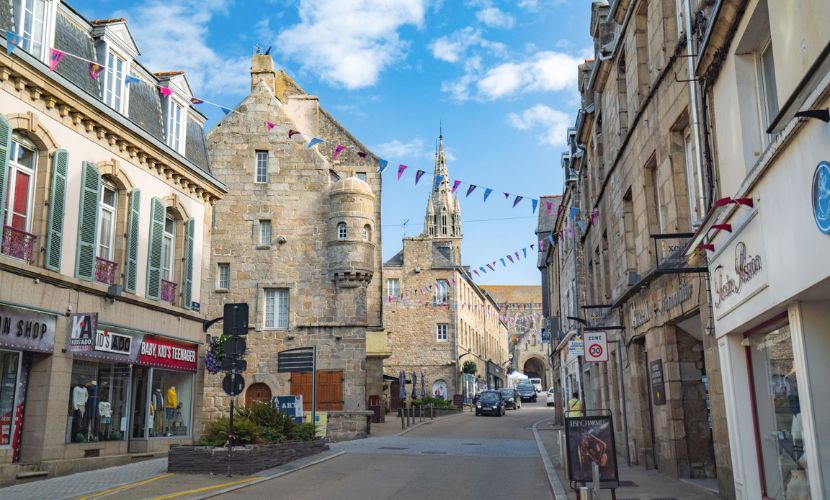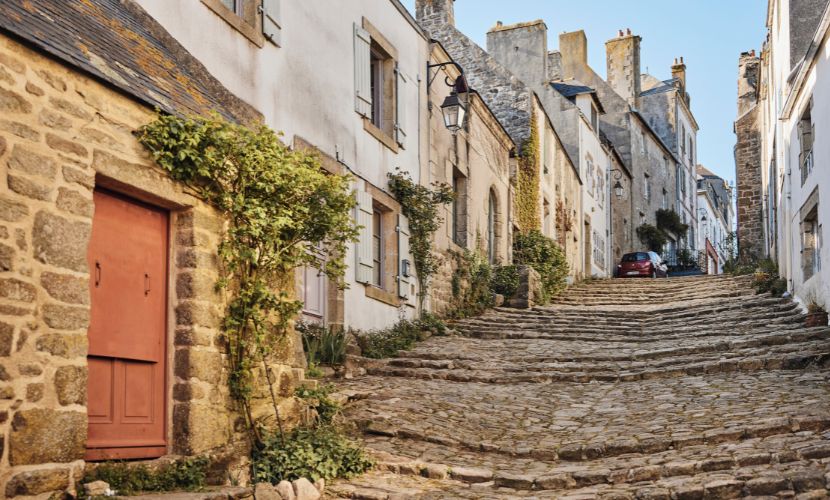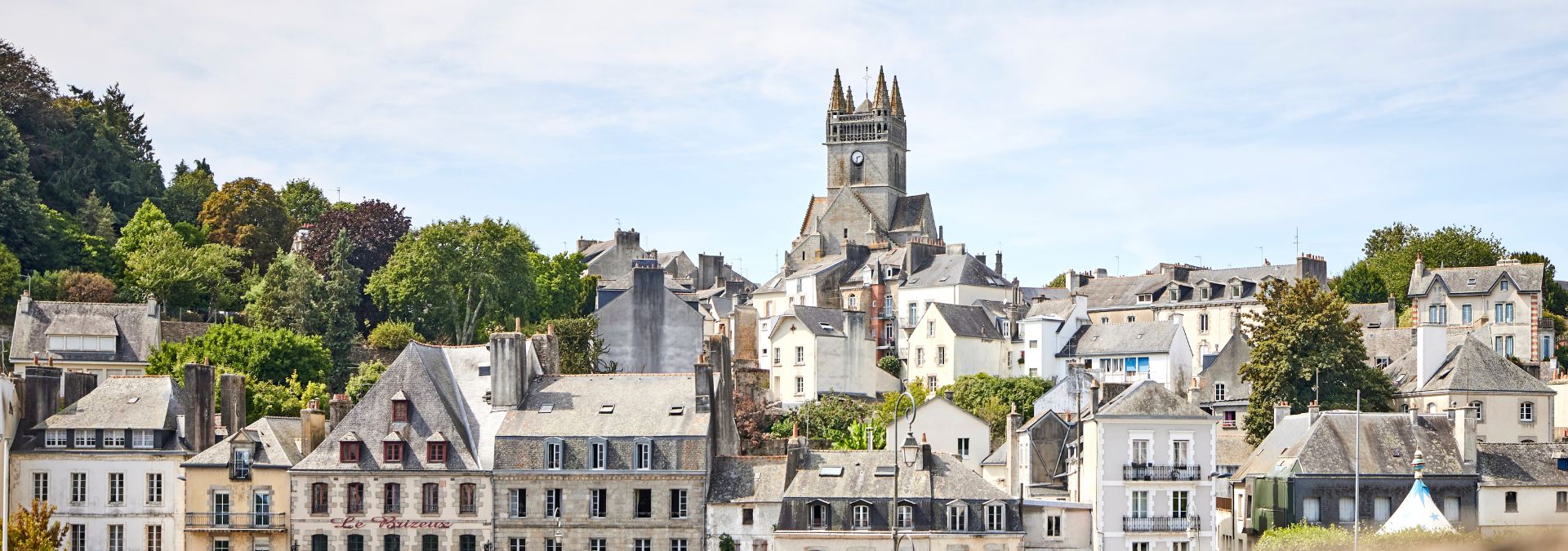
Landerneau, ‘city of the moon’
In the Rade de Brest, between the areas known as Cornouaille and Léon, the market town of Landerneau is nicknamed ‘the City of the Moon’. The moon has been the town’s symbol since the 1600s, when the Lord of Rohan had to replace the sun on his coat of arms to avoid antagonising Louis XIV, famously known as The Sun King. Since then, the moon has appeared on houses, in pastries and even in the festival held at the beginning of July, named Kann al Loar, or the ‘song of the moon’.
With a view to preserving and promoting its heritage, Landerneau has been officially recognised as a Town of Art and History. The old quarters reveal the richness of its maritime past and it may surprise you to learn that Landerneau developed and prospered thanks to its port activity dating from the Middle Ages. This is because it’s located at a crossroads between the coast and the inland regions, making it one of the main ports in Finistère, alongside Morlaix and Brest. Back in the 1600s and 1700s, flax, leather and wine were exported from Finistère all over Europe, and Landerneau’s quaysides were built in this flourishing period, as were the grand, cut-stone houses built by wealthy merchants.
You might be reminded of Venice’s Ponte Vecchio when you cross the famous Rohan bridge over the Elorn, as it’s one of the last inhabited bridges in France. A few steps away, the Saint-Thomas district is home to some of the town’s oldest buildings, including the ‘Maison aux 13 lunes’, or ‘house of 13 moons’. Named after the frieze of full moons adorning the upper storey of the façade, this property was built by a wealthy merchant in the 1500s and is now a listed building.
Housed in the former Capuchin convent, the Hélène et Édouard Leclerc Trust for Culture is an absolute must for fans of contemporary art as it attracts world-class exhibitions. More than a million visitors have already come to admire works by Miro, Chagall, Dubuffet, Picasso, Henry Moore, Enki Bilal and Giacometti.
Morlaix, the city of the viaduct
Whether you arrive by land or sea, the town of Morlaix – also known as the town of three hills – is instantly recognisable from its viaduct. Built in the 1800s to provide a rail link between Brest and Paris, this imposing structure dominates the skyline. Walk up to its first storey and from 20 metres above the ground, you’ll get a beautiful view of the town and its harbour. From the Middle Ages onwards, this port was one of the biggest in Brittany, where local commodities such as linen, leather, butter and horses were exchanged for metals, citrus fruits, wines and spices.
On the quayside, Maison Pénanault now houses the tourist office and the CIAP visitor centre for architecture and heritage and regular exhibitions. Dating from the late 1500s, Maison Pénanault is an architectural marvel: a manor with a monumental staircase, reception room, terraced gardens, covered gallery and a roof structure that’s the only one of its kind in Brittany.
Near the port, the former tobacco factory – La Manufacture – has been completely renovated and now houses a cultural centre, the SEW.
Some very old timber-framed houses line the narrow streets in the heart of the old town, physical traces of Morlaix’s rich and prosperous past. Among them, you can visit the Duchess Anne house and the Pondalez house to discover their typical architecture. Built in the 1500s by linen merchants, these two properties are arranged over three levels around a monumental fireplace, a spiral staircase and wooden passageways known as ‘bridges’.
Quimper, queen of Cornouaille
Quimper is named after the Breton word ‘kemper’ meaning ‘confluence’, as the town developed where the Steir and Odet rivers meet. Quimper is the historic capital of French Cornwall and it has been awarded the label of Villes et Pays d’Art et d’Histoire® for its artistic and historic interest. The prime example of this is undoubtedly Saint-Corentin Cathedral, a true masterpiece of Gothic art whose construction began in 1239 and continued for nearly 600 years. Listed as an Historic Monument, it is considered to be one of the most beautiful cathedrals in France. Adjoining this is the former Bishops’ Palace, which now houses the Musée Départemental Breton, a museum with an extensive collection of archaeology, ancient art, costumes and objects from Finistère. The old quarter around the cathedral immediately hints at the city’s medieval past, through its cobbled streets and colourful half-timbered and corbelled houses. The street names reveal how the town would have been organised into guilds, including Rue Kéréon for the cobblers and Rue des Boucheries for the butchers.
Follow the River Odet to the historic district of Locmaria, where you’ll find the Romanesque church of Notre-Dame de Locmaria – built in 1022, this is the town’s oldest religious building. It stands on an ancient Gallo-Roman site and forms a beautiful architectural ensemble grouped with its cloister and magnificent priory, a former Benedictine abbey. In the past, Quimper’s commercial activity was also based in this district, as it was so near the old port. Locmaria was also the birthplace of a particular hand-painted ceramic known as faïence. A museum dedicated to this craft traces three centuries of Quimper’s ceramic history through more than 5,000 pieces of painted earthenware. The renowned Henriot-Quimper factory is still in operation and is open to visitors.
Don’t miss the fine-arts museum Musée des Beaux-Arts de Quimper in the town centre. Its extensive collection covers more than five centuries of artistic creation, with European paintings of Breton inspiration, as well as a collection from the Pont-Aven School. It also pays tribute to the novelist and painter Max Jacob, a native of Quimper.
Locronan, a medieval town
You get an idea of Locronan’s historic status when you learn that the entire town was listed as an Historic Monument in 1924. Locronan has been granted the label Petite Cité de Caractère® (Small Town of Character) and is ranked as one of France’s Favourite Villages. Around 2,500 years ago, the town was a nemeton, a sacred path with stations symbolising the twelve months of the year. This path, created by the Celts to worship under the guidance of their druids, is the last site of this type still visible today.
In the 6th century, Saint Ronan made the site Christian and founded the town, which is named after him. From the 1300s onwards, Locronan gained in wealth and beauty thanks to the trade of weaving sailcloth.
Today, you can walk through Locronan to the Grand’Place and feel as if you’ve stepped back in time. It’s no surprise, therefore, that many film-makers have chosen Locronan as a film set. Around thirty movies have been shot here since 1920, including Jean-Pierre Jeunet’s ‘A Very Long Engagement’ and Roman Polanski’s ‘Tess’.
Brest, a city on the move
Brest was recognised as a city of artistic and historic interest in 2017, and as well as preserving its unique heritage and identity, the city has managed to reinvent itself over the years. All of Brest’s architecture has its origins in turbulent times. Although 90% of the city was razed to the ground during the Second World War, it has preserved its castle, the Tour Tanguy and several parts of the Recouvrance district, particularly the Rue de Saint-Malo.
Built on a Gallo-Roman foundation dating from the 3rd century, Brest castle was remodelled by Vauban in the 1600s, becoming a heritage treasure that was considered to be the strongest castle in the world. It later became a princely residence, a prison and a fortress for military protection, and today houses the French Navy Museum, Musée National de la Marine de Brest.
Opposite stands Tour Tanguy that dates from the 1300s and is the oldest building in Brest. Built at the head of the Penfeld river, it watched over anyone passing between the two banks of the city, either to protect or to prevent their passage. Since 1962, it has housed a museum dedicated to Brest’s past.
Brest is sometimes nicknamed ‘the white city’ because of the white plaster used on many of its facades. It’s a city with a real artistic spirit, home to many museums and exhibition spaces that offer a dynamic cultural calendar from the fine-arts museum and La Passerelle contemporary arts centre to the French Navy museum, Le Comoedia and the recently restored Ateliers des Capucins. Brest is also home to a number of high-quality cultural venues, including Le Vauban, Le Mac Orlan, La Carène, L’Arena and above all Le Quartz, which is France’s top national theatre in terms of audience numbers.
Le Conquet, a harbour at the edge of the world
Sheltered in an exceptional setting between the Kermorvan Peninsula and Pointe Sainte-Barbe, Le Conquet is France’s second-largest crab fishing port, renowned for its seafood and fine fish. The town, which has the Petites Cités de Caractère® label, has prospered since the 10th century thanks to its port, and its glorious maritime past can be glimpsed through its opulent houses, old port and shops. Don’t miss the Maison des Anglais, a small-scale fortress from the 1400s also known as the Little Castle of Le Conquet. Perched high above the harbour it has somehow survived through the centuries.
Also impressive is the Maison des Seigneurs, built in 1510 to protect the port from attack. The church of Notre-Dame-de-la-Sainte-Croix, built in 1850, houses the tomb of Dom-Michel le Nobletz, a major figure in the diocese of Quimper and the lands of Léon.
At the end of the peninsula stands the square tower of Kermorvan lighthouse, one of the few spared by German troops during the occupation.
Concarneau, a fortified town
The old walled town of Concarneau sits on an island nestling in a cove, and the town itself has been awarded the Villes et Pays d’Art et d’Histoire® label. An ancient defensive site, the walled town is surrounded by granite ramparts, nine towers and three gates. Concarneau’s oldest properties include some wonderful examples of timber-framed houses, stalls with carved lintels and chapels that have been converted into homes. This fortified town dates back to the 1400s and as the population gradually outgrew the space, they began to build on the neighbouring banks.
The ‘blue’ town has always prospered thanks to the sea, from early fishing to canning, shipbuilding and the later development of seaside tourism. The Musée de la Pêche at the entrance to the walled town traces Concarneau’s sea-fishing history through an impressive collection of boats, models and marine artefacts.
The history of Concarneau port dates back to the Middle Ages, when the site was a small fishing village with a natural shelter where boats could come to take refuge from storms. Over the centuries, the port grew and expanded until by the 1900s it was France’s top tuna port. Today, it is still the number-one tuna port in Europe and the third biggest fresh fishing port in France.
Roscoff, town with a pirate past
Built on a peninsula, Roscoff has been officially recognised as a small town of great character (Petite Cité de Caractère®), combining the charm of a harbour town with that of a seaside resort. As you wander around the old streets, you still get a sense of its chequered past, featuring smugglers, pirates and wealthy merchants. After the late Middle Ages, the town attracted sailors from all over the world and prospered thanks to the boom in maritime trade, particularly linen, wheat, salt, wood and the famous onion-sellers known as ‘Johnnies’. This flourishing trade lined the pockets of local merchants, who built opulent mansions of cut granite with a number of distinctive features, including sculpted dormers, mullioned windows, cellars that open onto the street outside and staircase turrets.
In the centre of the town stands the church of Notre-Dame de Croas-Batz, built in the 1500s. The building is faithful to the Finistère tradition of elaborate parish churches, once surrounded by an enclosed cemetery; its two ossuaries are still visible today, one of which was transformed into the chapel of Sainte-Brigitte. Take a close look at the stones of the church, and you’ll notice that some features carvings of ships – apparently these were commissioned by merchants seeking God’s blessing and protection for their maritime ventures.
Guerlesquin, land of Trégor
Guerlesquin has been proudly bearing the Petite Cité de Caractère® label since 1970 and sits in the ancient region known as Trégor, on the borders of Léon and Cornouaille. It has a town centre that is unique in Brittany, as it is built around three successive squares: Liberty Square, Martray Square and Battlefield Square.
Situated within the Armorique Regional Nature Park, the whole town seems to have been carved out of stone. The beautiful and rather sombre-looking granite mansions that line the central squares are physical reminders of a prosperous commercial past. They bear evocative names: Maison de la Tourelle, Maison du Prévôt, Maison du Bourreau and invite you to admire their elaborate facades, their finely-worked cornices and dormer windows.
In the centre of the village stands a tiny building that looks like a fortress and was once where the local lord locked up any prisoners. Saved from destruction in 1856, this prison was listed as a Historic Monument in 1875. Its prime location and Renaissance-style architecture are simply astonishing and if you’d like to look around, the tourist office organises tours.
A few steps away you’ll see another landmark, the old covered market halls. Built in 1525, they collapsed in 1879 and were rebuilt in granite, proving that local commerce was still alive and flourishing here in the 1800s. The little town also boasts a rich religious heritage, with the flamboyant Gothic church of Saint-Ténénan, as well as six small chapels built in the 1500s and 1600s, including the pretty chapel of Saint-Jean that is squeezed in between two old houses.
Guerlesquin holds a market every Monday that is especially lively in summer, and it’s one of the last villages in France to have its own animal market, continuing its long tradition of livestock fairs.
Pont-l’Abbé, the Bigouden town
Capital of the area known as Pays Bigouden and nestling at the head of the estuary, the historic town of Pont-l’Abbé owes its name to its inhabited bridge, one of the last in France alongside that of Landerneau.
The Château des Barons, built in the 1200s and 1300s, was built to guard the entrance to the town, as this was the main gateway to Pays Bigouden. Nowadays, it houses the town hall and museum and when you visit the Musée Bigouden, you can see the castle keep. The museum houses a fine collection of the area’s traditional costumes, headdresses and furnishings, examples of excellent Bigouden craftsmanship.
The town’s streets and squares are dotted with beautiful facades and mansions from the 1500s and 1600s. Most of the large mansions that can still be seen today were built by the bourgeoisie who made their names in the agricultural produce trade. Today, Pont-l’Abbé continues its trading tradition, with an impressive 250 shops for a population of just 8,000, not counting its must-see Thursday-morning market!
Le Faou, at the gateway to the Crozon Peninsula
Sitting between the Arrée Mountains and the Rade de Brest, Le Faou has been awarded the Petites Cités de Caractère® label. With no fewer than 27 buildings protected as Historic Monuments, Le Faou is second only to Quimper for its architectural heritage.
Le Faou still shows traces of its former prosperity that came from the port and its trading history. Wander through the streets admiring the timber-framed houses and you’ll be transported back to the town’s golden age, when the port was a bustling place shipping timber. Opposite the port, at the end of the Steir Goz waterway, is the church of Saint-Sauveur. Built in the 1500s, it is worth a look for its baptismal font with sculpted decorations that make it unique in Brittany.
Between a stroll along the seafront and a walk in Cranou Forest, make a diversion to Rumengol, once a major pilgrimage destination, whose 16th-century church was built on a former druidic site.
Quimperlé, the city of three rivers
Quimperlé sits at the confluence of three rivers, the Ellé, the Isole and the Laïta, and has been awarded the label of Villes et Pays d’Art et d’Histoire®. You can explore the town by walking along cobbled streets, staircases, bridges and footbridges. Historically, Quimperlé developed around its abbey and port, thanks to imports of wine, salt, limestone and slate, but it also exported grain, honey, meat and timber. The Benedictine abbey of Sainte-Croix, founded in 1029, was one of the richest in Brittany in the Middle Ages, with architecture typical of Romanesque churches, inspired by the Church of the Holy Sepulchre in Jerusalem.
The beautiful stone mansions and elegant townhouses testify to Quimperlé’s wealthy past. Over the centuries, as boats grew ever larger, it became more difficult to sail up the Laïta River and consequently the port lost much of its influence. It then became a place of tranquillity and inspiration for the artists who arrived by train and helped to found the Pont-Aven School of art.
Saint-Pol-de-Léon, a picturesque town
The former cathedral city of Léon, Saint-Pol-de-Léon is undoubtedly one of the most picturesque towns in the region. It combines the charm of a small harbour village with a rare architectural heritage that comes from its grand status as the former bishopric of Finistère. In the heart of the town, the chapel of Notre-Dame-de-Kreisker rises 78 metres into the sky – its bell tower is the second tallest in Brittany and one of the tallest in the world. Take time to admire its stained glass windows and pay particular attention to the rose window in the west gable. This stained glass window symbolises the divine mystery through its symbolic colours: red for the Holy Spirit, yellow for joy and blue for purity.
Continue your tour through Saint-Pol-de-Léon, exploring the narrow streets of its historic centre. Admire the sculpted facades of the grand properties built by shipowners that once brought so much wealth to the town. From the Maison de l’Artichaut, follow the arrows on the ground featuring the dragon, the town’s legendary symbol. If you’d like to learn about the history of Saint-Pol (after whom the town is named) you can read it on the 28 enamelled plaques installed at the foot of the town’s monuments.
On the coast, don’t miss the Dolmen de Kérangouez standing stone, also known as the Boutouiller or Kérivin dolmen. Now a listed monument, it was erected in the Neolithic period (around 5,000 BC), and is the only remaining trace of an ancient settlement here.
Pont-Croix, the picturesque town
Situated in the heart of the Goyen Valley, Pont-Croix is the historic capital of the far-western coastal area known as the Cap Sizun and has been awarded the label of Petite Cité de Caractère®. Its finest monument is undoubtedly its collegiate church, Notre-Dame-de-Roscudon, which was built in the 1200s by the lords of Pont-Croix and is a true masterpiece of Romanesque and Gothic architecture. It inspired many other religious buildings in the region, including Saint-Corentin Cathedral in Quimper.
Take your time wandering through the cobbled streets and immerse yourself in the medieval atmosphere, admiring the sites that have inspired artists such as Max Jacob and Henri Matisse. The old town centre has preserved some fine homes dating from the 1400s to 1800s and the Marquisat – a former nobleman’s house – now houses the Heritage Museum. Follow the steep stone steps down to the old river port. Once accessible to ocean-going vessels, it played a major role in the commercial development of Pont-Croix, alongside its tapestry factories and cannery.

